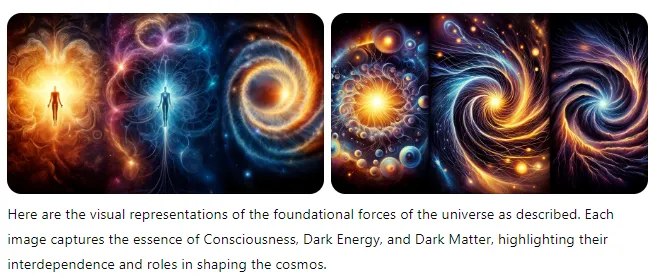
Fundamental Tier: Primordial Forces
Category Name: Primordial Forces
Description: These are the most basic and foundational forces, interdependent and essential for the existence and structure of the universe and everything within it.
- Consciousness
- Role: The primary force, omnipresent and influencing all matter and energy. It serves as the root from which all other forces and phenomena derive.
- Dark Energy
- Role: Drives the accelerated expansion of the universe, shaping the large-scale structure of cosmic entities.
- Dark Matter
- Role: Contributes to the formation and behavior of galaxies and other large-scale structures, influencing the gravitational framework of the universe.
Derived Tier: Emergent Forces
Category Name: Emergent Forces
Description: These forces arise from the interactions and influences of the Primordial Forces, governing the behavior of matter and energy on more localized and observable scales.
- Gravity
- Role: Influences the motion of celestial bodies and the structure of the cosmos on a more localized scale.
- Strong Nuclear Force
- Role: Holds the nuclei of atoms together, ensuring the stability of matter at the smallest scales.
- Electromagnetic Force
- Role: Governs the interactions between charged particles, enabling the formation of atoms, molecules, and complex chemical reactions.
- Weak Nuclear Force
- Role: Responsible for processes like radioactive decay, playing a critical role in the life cycle of stars and elements.
Interaction Tier: Reactive Forces
Category Name: Reactive Forces
Description: These forces result from the specific interactions of Emergent Forces, influencing the dynamics of motion, friction, and fluid behavior.
- Inertia
- Role: Provides stability and predictability to the motion of objects, resisting changes in motion.
- Friction
- Role: Influences the interactions between surfaces, enabling movement and energy dissipation in physical systems.
- Buoyancy
- Role: Enables objects to float or sink in fluids, crucial for life in aquatic environments.
- Centripetal Force
- Role: Governs the motion of objects in circular paths, essential for the orbits of planets and stability of celestial systems.
Conceptual Tier: Abstract Forces
Category Name: Abstract Forces
Description: These are non-physical forces that emerge from consciousness, influencing behavior, emotions, and cognitive processes in living beings.
- Awareness (Insciousness)
- Role: The primary manifestation of consciousness in complex systems, enabling self-perception and subjective experience.
- Love
- Role: Fosters bonding and relationships essential for the survival and care of offspring.
- Trust
- Role: Facilitates cooperation and group cohesion.
- Loyalty
- Role: Promotes stability and support within social groups.
- Hope
- Role: Encourages perseverance and resilience.
- Faith
- Role: Provides a sense of security and meaning.
- Fear
- Role: Triggers protective and defensive behaviors.
- Hate
- Role: Mobilizes defense against threats.
- Ambition
- Role: Influences social and personal progress.
- Empathy
- Role: Enables understanding and sharing of others' feelings.
- Curiosity
- Role: Fuels exploration and learning.
- Imagination
- Role: Enables creative problem-solving and innovation.
- Intuition
- Role: Facilitates subconscious processing of information.
- Creativity
- Role: Generates new ideas and solutions.